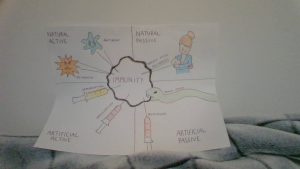
My STEAM piece is on the learning objective “Describe how immunity can be acquired through passive and active means.” This was a very intriguing unit for me – the lymphatic and immune system – because it is constantly defending our bodies, but often goes unnoticed. I decided to demonstrate the different ways immunity can be acquired through a drawing. Please excuse my lack of artistry skills, creative supplies, and terrible camera. I do not have access to much since I’m currently deployed, and my phone no longer works so I had to use my laptop camera. Bear with me.

This piece helps the viewer imagine the multifaceted nature of immunity. There are 4 ways immunity can be obtained and different aspects artificial vs natural and passive vs active. One part that stands out is the snake biting the “immunity” cell. This helps the viewer understand how the immunity responds to nature ironically a form of artificial passive immunity. On the other hand, the depiction of the mother breastfeeding the child as a form of natural passive immunity makes it clear what is considered natural in terms of immunity. It helps the user understand that natural passive immunity has to do with human cells natural to the individual whereas artificial passive immunity comes from cells from something other than itself. The faces on the antigens and pathogens help the viewer understand how they interact with the body. The sad antigen and wavy outline suggest that the end goal is to infect the body and cause illness as a general goal. The sharp and rigid outline along with the mean or angry face of the pathogen suggest that it is more involved in agitating the body. It makes it clear they are working together because they are designed with a similar structure. Overall the piece is designed well, it is split into 4 corner sections that make it look well structured. Everything circles around the cell in the middle and helps bring the whole piece together. It is easy to understand and has a satisfying layout.
Nice job Kelsea, well done.